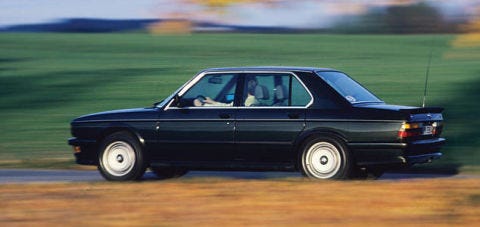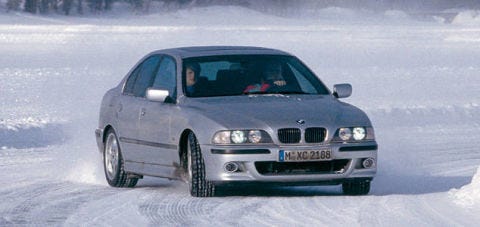2005 Bmw M5 Review

In 1972, while the rest of the world was absorbed by the Watergate scandal and Mariner 9's beaming back the first close-ups of Mars, BMW Motorsport GmbH was born. Under the direction of a nascent Bob Lutz (then worldwide head of BMW Sales and Marketing) and leadership of Jochen Neerpasch, the performance subsidiary first concentrated on touring car racing and created the famous and successful 3.0 CSL "Batmobile." For homologation purposes, a limited number of road-going cars were built, giving BMW Motorsport its first experience with road cars.
In 1978, BMW presented the 2-seat mid-engine M1, whose new twincam 3.5-liter straight-6 would provide the performance foundation for later cars. One example was famously hand-painted by Andy Warhol in 1979, the fourth in a series of the now widely renowned Art Cars, and was raced at Le Mans that year. Again, homologation required M1 road cars to be built, so 445 examples were produced between 1978 and 1981, the engine making 177 bhp in this configuration.
On the pure racing side, who could forget Formula 1's 1.5-liter turbo era, with the stock-block M Power BMW in Nelson Piquet's Brabham BT50 making upward of 1200 bhp in qualifying trim. Exciting days, and that Parmalat-sponsored Brabham was one of the prettiest cars of its time, too. Piquet went on to win the F1 World Drivers Championship in 1983, driving a BMW-powered BT52.
Although never seen on U.S. shores, the M5's handbuilt precursor was based on 1979's E12 chassis, the very first 5 Series. As BMW's press release reads, "As often happens when one leaves racing engineers with too much time on their hands, the temptation to take a standard production sedan and shoehorn a larger, more powerful engine into it proved too much to resist." The embryonic M5 made 218 bhp, and was sold in very limited numbers.
In 1993, the motorsports and road-car businesses were separated, and BMW Motorsport GmbH became BMW M GmbH. What follows is a sampling of its M5s over the years.
1988 BMW M5 (E28 chassis)
Although exterior changes were rather tame for this first U.S. M5 (The Wolf in Sheep's Clothing, as it came to be known), its engine bay held a derivative of the mighty M1's 3.5-liter twincam 24-valve straight-6. European versions (sold as the M535i) made 286 bhp, but U.S. models were detuned to a still-impressive 256 bhp, enough to keep pace with a Porsche 928 S. It was the first savory taste of the M-calibrated suspension, and our first peek at the iconic row of six individual throttle bodies and competition-look airbox. Worldwide, a total of 2241 cars were delivered, making this M5 a rare bird indeed.

1988 BMW M5 (E28 chassis)
1991 BMW M5 (E34 chassis)
The early 1990s saw a stronger 3535-cc straight-6, now 310 bhp, in the more modern bodyshell. Subtlety in appearance was still BMW's modus operandi, but the M5's odd aluminum/magnesium wheels, whose thick rim flanges gave the tires the appearance of being whitewalls, were aesthetically questionable. Although curb weight had crept to 3950 lb., acceleration was fleet for its day—6.4 seconds to 60 mph and 15 sec. flat in the quarter mile. In our road test (August 1990), we raved about its engine response and pointable chassis but cursed its high price ($56,600 base, a considerable fortune two decades ago). In sum, we said it "was a rolling tribute to BMW confidence."

1991 BMW M5 (E34 chassis)
1999 BMW M5 (E39 chassis)
Into what many consider the cleanest 5 Series body style ever made was plugged the first M5 V-8 engine, a 4-cam 4941-cc jewel that produced 400 velvety horsepower and revved to 7000 rpm. The individual throttles (now servo-controlled) remained, but hidden in a massive carbon-fiber plenum spanning the cylinder banks. Curb weight still hovered around the 2-ton mark, but the E39 M5's superior power-to-weight ratio enabled a 0–60 Sturm of 5.0 sec. and a quarter-mile pass of 13.4. In our March 2000 test, we praised the engine's eagerness ("The M5 literally leaps from corner to corner..."), but found fault in the otherwise polished handling, with too much midcorner understeer.

1999 BMW M5 (E39 chassis)
2005 BMW M5 (E60 chassis)
Say what you will about the E60's angry librarian scowl and its unusual trunk cut lines, but this M5's 500-bhp V-10 engine delivered, with a 4.1-sec. 0–60 sprint and a drag strip E.T. of 12.4 sec. Oddly, it didn't feel that fast, partly due to soft tip-in torque. The E60 also marked the first M5 not available with a conventional manual transmission; the 7-speed paddle-shift SMG (Sequential Manual Gearbox) was standard, with 11 selectable shift profiles. Purists complained, and BMW did eventually offer the car with a 6-speed manual in the U.S. We summed up the new 5 thusly after its European introduction: "The fourth-generation M5...proves that ultra-high technology and driving excitement can indeed coexist in the same vehicle."

2005 BMW M5 (E60 chassis)
This content is created and maintained by a third party, and imported onto this page to help users provide their email addresses. You may be able to find more information about this and similar content at piano.io
Source: https://www.roadandtrack.com/car-culture/a17675/coming-to-america-the-bmw-m5/
